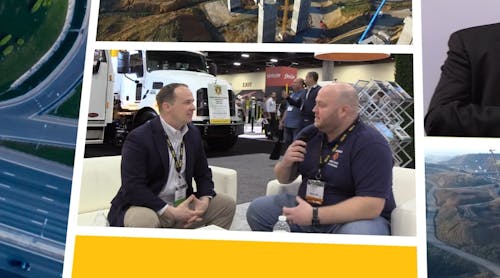The Teodoro Moscoso Bridge is the longest bridge spanning a body of water in Puerto Rico. The four-lane, 1.4-mile-long toll bridge spans the San José Lagoon, connecting the cities of San Juan and Carolina while also serving as the main entrance to the Luis Munoz Marin International Airport. The total length of the bridge including access roadways is 2.1 miles.
Although owned by the Puerto Rico Highways and Transportation Authority (PRHTA), the bridge is managed and maintained by Albertis, a private toll road management company based in Spain, through a public-private partnership with PRHTA.
In summer 2015, Albertis began a comprehensive rehabilitation program for the more than 20-year-old bridge, which involved various levels of repair. With the airport on one end and a premier shopping destination (the Mall of San Juan) on the other, the bridge is subjected to a high level of vehicle traffic. The goal was to perform repairs with minimal road closures for drivers.
Bringing work in house
Albertis decided to perform all concrete repair work in house to save money and have more control over the pace of work. The company’s bridge design department and bridge operation manager also worked closely with San Juan-based contractor AT Specialty Cements & Polymer Technologies to identify repairs needed, determine causes of concrete deterioration, and select products that would minimize traffic disruption.
AT Specialty Cements recommended several fast-setting hydraulic cement products by CTS Cement. The company’s Rapid Set product line allows users to build faster and reduce downtime.
The contractor also provided technical training to bridge maintenance personnel and as-needed assistance throughout the project duration.
All concrete repairs were related to concrete deterioration caused by corrosion of the reinforced steel—a direct result of chloride penetration in the concrete. Training was based on International Concrete Repair Institute guidelines for concrete repairs caused by corrosion, as well as manufacturer guidelines provided by CTS Cement.
The repairs were accomplished in three separate phases.
Phase 1: Partial-depth repairs
During the first stage of the rehab program, a soundness test was performed in areas of the pavement near the toll plaza, where corrosion deterioration and concrete delamination were evident. The 10-person maintenance crew found that the top rebar did not have enough concrete cover, thus was attacked by the high concentration of chlorides in the environment. This, in turn, caused deep cracks and fragmentation in the concrete.
AT Specialty Cements recommended partial-depth repair, which consists of removing the top one-third of damaged slab and replacing it with appropriate repair materials. Although the method is faster and less costly than having to replace a slab down to the base, the bridge’s operation manager, Ing. Juan Matos Ostolaza, still had concerns about the downtime needed to repair these sections in close proximity to the high-traffic toll booth.
To minimize road closure time, Matos Ostolaza and the bridge design department needed a very fast structural mortar with early high strength to perform the partial-depth repairs. After months of product evaluations, they selected CTS Cement’s Rapid Set DOT Repair Mix.
They also added Rapid Set Corrosion Inhibitor to the DOT mix, which creates a protective barrier on embedded steel that repels water and reduces chloride ion permeability. As part of the Rapid Set family of products, the powder additive can be combined with any Rapid Set repair product during the mixing process to protect against corrosion.
The maintenance crew executed all repairs under the direction of the manufacturer’s technical data. In addition, Matos Ostolaza performed rigorous inspections along the way.
The fast-acting products enabled the crew to open all lanes to traffic three hours after repairs were made, which meant minimal interruption to the operation of the toll plaza.
Phase 2: Lateral barrier repair
The lateral barriers of the bridge were at least 26 years old, with concrete delamination spalling that was quite evident in numerous areas. An extensive field study found that almost 45% of the barriers’ vertical surface had some degree of concrete deterioration due to corrosion. As with the pavement near the toll plaza, the corrosion was caused by lack of sufficient concrete coverage of the reinforced bars.
All damaged areas were scattered spots—isolated areas approximately 5x5 ft and 8x8 ft in size—so the bridge needed a durable yet aesthetic solution that would blend well with existing concrete. To do this, AT Specialty Cements recommended V/O Repair Mix for all vertical partial-depth repairs. The mix is tinted gray to match most Portland concrete surfaces. It also bonds well with existing concrete and is resistant to both freeze/thaw and corrosion. Corrosion Inhibitor also was added to the mix.
The crew finished the barrier surfaces with a thin layer of WunderFixx, a high-performance patching product, to provide a smooth surface ready to receive the anti-carbonation protection coat.
The original plan was to repair 300 ft of barrier, but as the bridge’s management team found how quickly and easily the crew could perform repairs with the fast-setting materials, they extended the work to 1.5 miles of barrier. Soon after, they decided to repair the other side of the bridge (another 1.5 miles) and the toll plaza structure.
In the end, the maintenance crew repaired more than 25,000 linear ft (4.8 miles) of concrete barriers.
"It was great to see the crew working with materials that allowed them to complete repairs in a highly efficient manner," says Matos Ostolaza.
Phase 3: New floor drains
During the final phase of the project, a new system of floor drains was needed on the east side of the bridge to allow all surface water to discharge.
For the new drainpipe installation, the crew core-drilled the new drains and saw-cut and chipped out the drain ditch with a jackhammer. The new pipes were anchored and fixed with Cement All, a fast-setting, high-strength, non-shrink grout. The multipurpose product typically sets in 15 minutes and is ready for traffic in one hour. Again, the crew added Corrosion Inhibitor to the mix. The drain ditch was finished with CR Concrete Resurfacer. Typically used to resurface damaged or discolored concrete, the resurfacer is formulated with self-curing technology, so it does not need to be wet-cured in most applications.
Quick and easy
The Rapid Set products were easy to mix, apply and clean, and produced minimal waste—even with a constant breeze and temperatures soaring above 90°F. To keep materials from setting too quickly in the high heat, the crew used iced water and added two packets of SET Control for every 50 lb of Rapid Set product during the mixing process. When added to packaged hydraulic cements, the SET Control additive slows setting time.
Each product cured in two hours, allowing the crew to move on to the next phase quickly.
The company was pleased with the cost savings achieved. A small crew was able to repair a large number of areas in a very short time—and with durable results. The areas repaired during the summer of 2015 still look great a year later, even though they are subject to a high volume of traffic.












